II
‘The forms making up the total gamut are therefore determined in three stages. First, three primary groups, blocks, bars and slabs, are separated out from a central group. Then each primary group is subdivided into a central form and three small groups qualified as short or long, narrow or broad, flat or thick. Lastly each of these small groups comprises three specimens. In the middle of these nine small groups lies the group of three outstanding white forms surrounded by the three forms transitional between the three primary groups.’ (VDL AS X, 9)
The white forms are the most important. They are a group of six forms that are neither block, nor bar, nor slab.
‘From this superior group they separate out into blocks, bars and slabs, as light divides into the colours of the rainbow. We will therefore call the forms of the core group, by analogy, “white forms”.’ (VDL AS X, 7)
The three white forms in the corners are essentially transitional forms between the forms of block and slab, between block and bar, and between bar and slab.
‘However, the three central white forms have something in common with all three forms. The three categories, block, bar and slab, meet together in an ideal form which does not exist as such but presents itself as blocklike in one form, barlike in another and slablike in the third. Because of their outstanding value these three forms play a leading role in architecture.’ (VDL AS X, 8)
Derived forms are also possible. They can be seen as a doubling of an authentic form.
 © drawing by HvdL, 26 November 1984
© drawing by HvdL, 26 November 1984

 © drawing by HvdL, November 1977
© drawing by HvdL, November 1977
